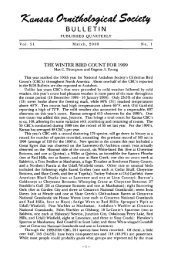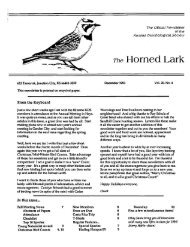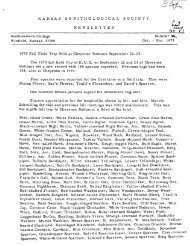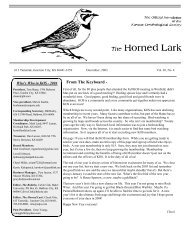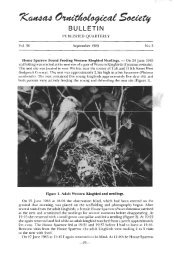BULLETIN - Kansas Ornithological Society
BULLETIN - Kansas Ornithological Society
BULLETIN - Kansas Ornithological Society
You also want an ePaper? Increase the reach of your titles
YUMPU automatically turns print PDFs into web optimized ePapers that Google loves.
Gull at Lawrence (their first record); one Thayer's Gull (Wilson Reservoir); one<br />
Glaucous Gull (Cheyenne Bottoms); two Inca Doves (one each at Lakin and Meade<br />
County); two Greater Roadrunners (one each at Red Hills and Yoder); one Lewis'<br />
Woodpecker (Scott Lake; first since 1995); three Eastern Phoebes (one at Linn<br />
County and two at Red Hills); one Steller's Jay (Liberal/ Seward County; last seen in<br />
1989); 5 Western Scrub-Jays (six at Ulysses, four at Garden City, three at Cimarron<br />
National Grasslands, and one each at old Garfield and Syracuse; only recorded twice<br />
in the last 12 years); two Pinyon Jays (Ulysses); one Clark's Nutcracker at Oskaloosa/<br />
Perry Lake (the first in the state since 1972); one Chihuahuan Raven (Liberal/<br />
Seward County); one Rock Wren (Canyonlands/ SE Logan County); three House<br />
Wrens (El Dorado); two American Pipits (one each at Liberal/ Seward County and<br />
Oskaloosa/ Perry Lake); one Orange-crowned Warbler (Wichita); four Vesper<br />
Sparrows (Cimarron National Grassland); three Leconte's Sparrows ( one each at<br />
Emporia, Halstead-Newton, and Quivira); seven Snow Buntings (six at Black Wolf<br />
and one at Wilson Lake); four Common Redpolls ( one at Cimmarron National<br />
Grassland and three at Manhattan); and six Evening Grosbeaks (five at Salina and<br />
one at Yoder).<br />
Only four of the counts (7%) reported completely frozen open water during the<br />
period, so potential habitat for waterfowl on larger bodies of water was plentiful.<br />
Several geese and ducks had greater numbers than the highest count since 1990,<br />
including Snow Goose (536,325 with forms combined was 250% greater), Ross'<br />
Goose (478 was 45% greater), Common Goldeneye (10,205 was 5% greater) and<br />
Common Merganser (90,279 was 27% greater).<br />
Numbers of Sharpshinned Hawks (125) were only slightly higher than the highest<br />
count (123) since 1990 and well above the average (96) for that count period. A<br />
remarkable six Goshawks on six different <strong>Kansas</strong> counts edged above the highest<br />
count of 4 (average 2.3) for the past 12 years. The 50 Merlins observed this year is not<br />
a record, but considerably above the average (34) during the last decade.<br />
Quail numbers have been of some concern the past few years as their numbers<br />
have declined dramatically. The 866 Northern Bobwhite counted this year is almost<br />
double last year's count (496) but still nowhere close to the average of 1952 individuals<br />
for the past 12 years. Only 6 Scaled Quail were counted this year (well below the<br />
mean of 58 for the past decade), but then they were only discovered on two counts.<br />
Owl numbers were comparable to past years with the exception of Barred Owls.<br />
The 22% increase noted last year was surpassed with another 45% increase this year<br />
(from 138 last year to 200 this year). The average for the past decade has been 98.<br />
The increase doesn't seem to be a function of hours of owling.<br />
Eurasian Collared Doves increased another 20% this year (from 245 to 295) and<br />
appeared in 3 more count circles than last year (from 15 to 18 counts). Red-bellied<br />
Woodpeckers showed a slight increase (1858) over their highest recorded number<br />
(1854) since 1990. No similar increases were noted in other woodpeckers. The 124<br />
Loggerhead Shrikes is a five year high but still slightly below the mean for the past 12<br />
years (128).<br />
Several species of common resident and winter visitant woodland birds seemed<br />
more abundant this year and this gened impression was confirmed by increases on<br />
the 2002 count. White-breasted Nuthatches, for example, increased 35% over their<br />
highest totals of the past decade (from 942 to 1274 individuals), Brown Creepers<br />
increased 21% (from 261 to 317), and Goldencrowned Kinglets 85% (from 688 to<br />
1275). Even the Winter Wren surpassed its record (from 61 to 77) and was well above<br />
the average of 20. It was a good year for Hermit Thrushes too (the 25 this year is close<br />
to the 29 record in 1998 and well above the average of 8).<br />
Some other species that surpassed their records of the past decade were<br />
Mountain Bluebirds (from 1670 to 1897 this year), Gray Catbirds (only by one, from



